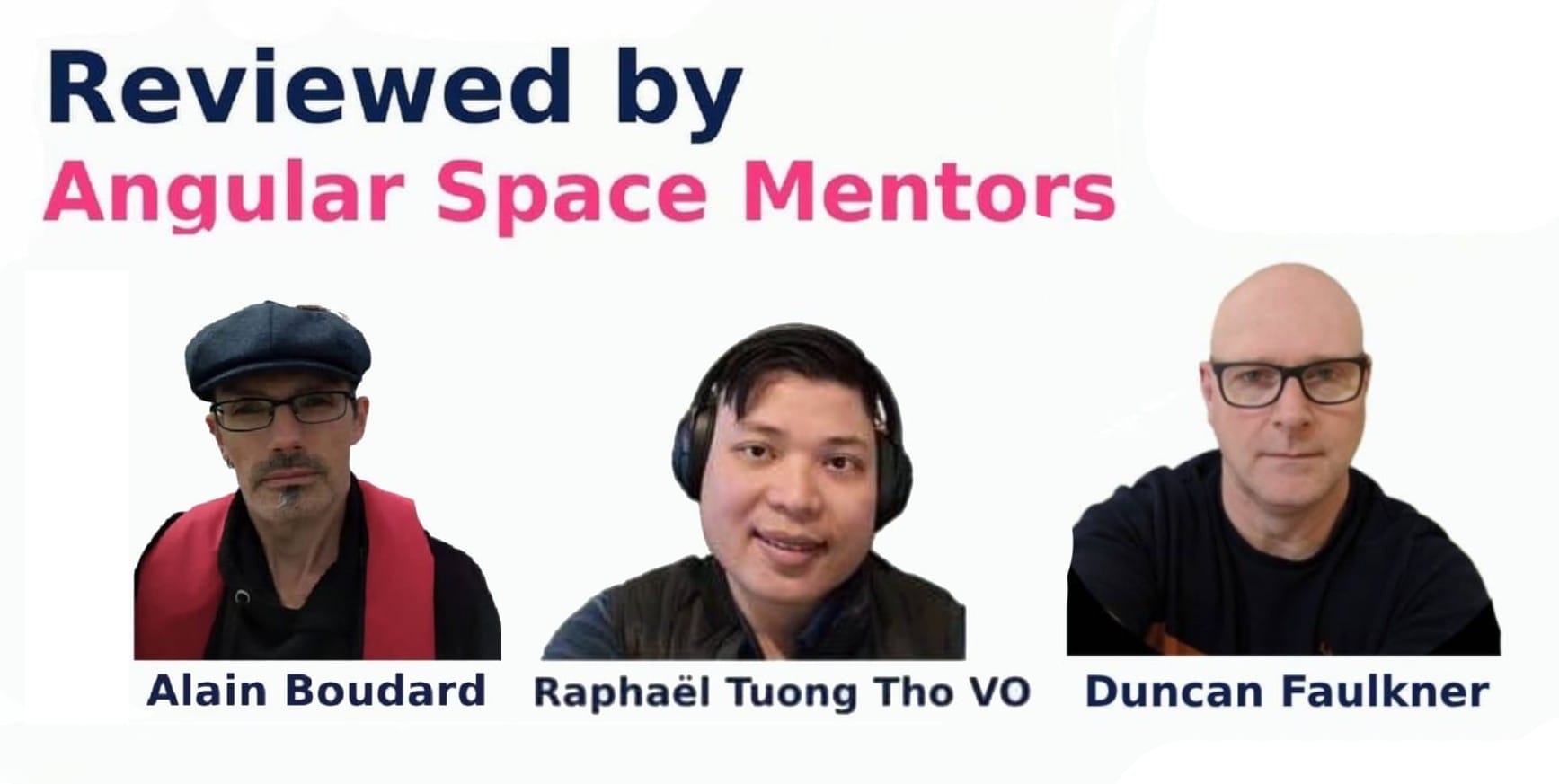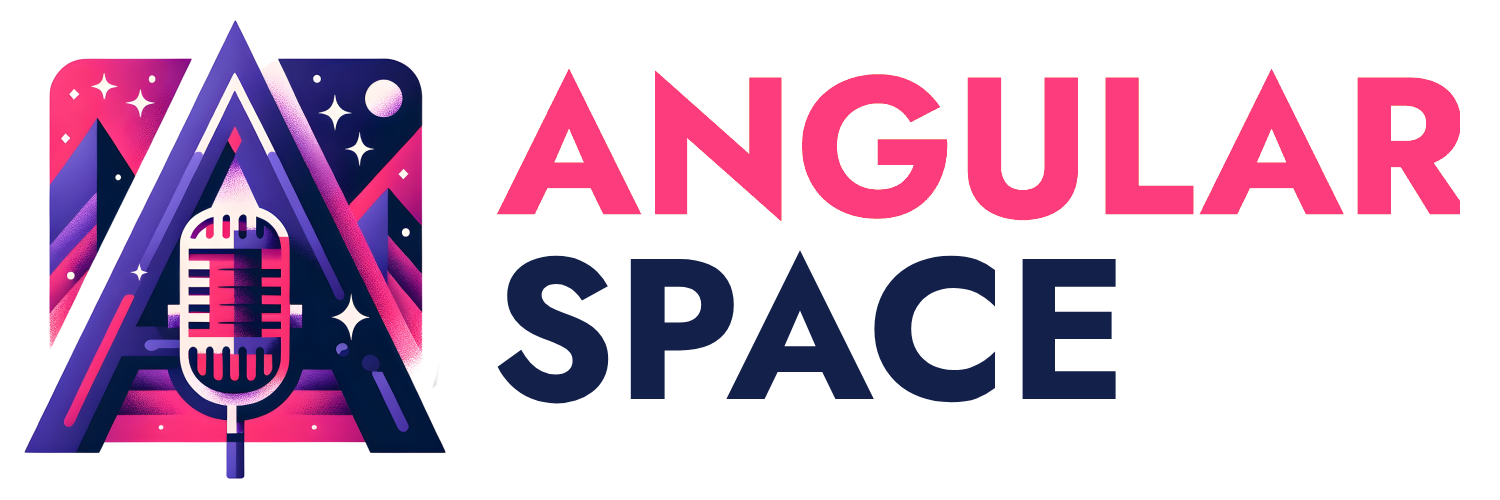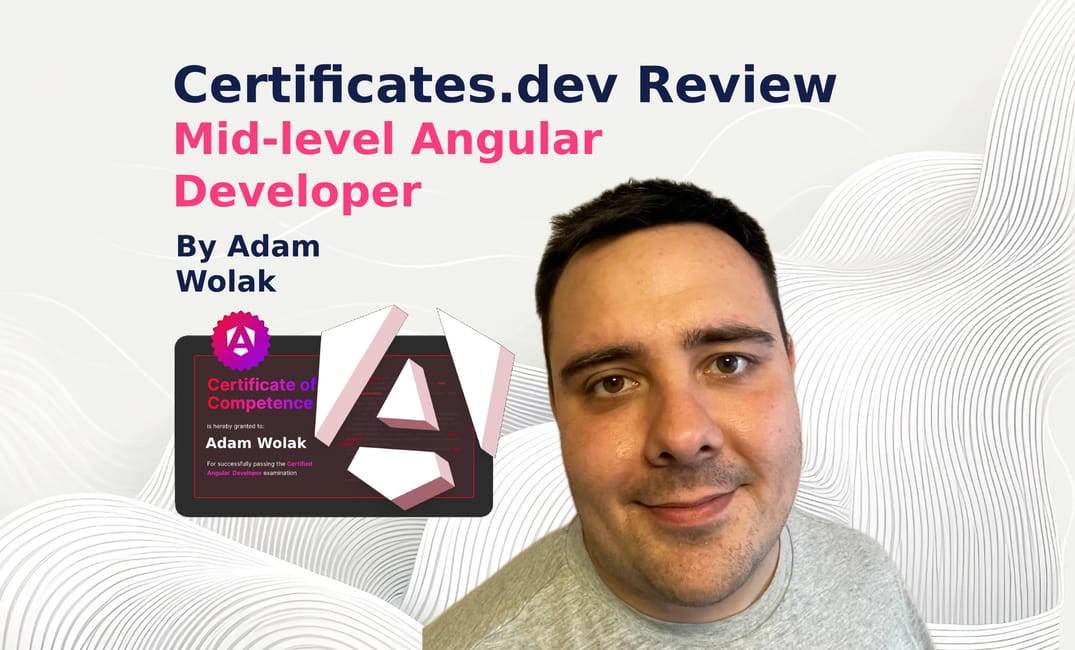Although Angular is regarded as an "enterprise framework," developers often struggle to prove their knowledge without practical tasks. Of course, there's the "Google Developer Experts" program, but some of its requirements might deter potential experts, and it doesn’t focus solely on Angular - Instead, it promotes Google technologies such as cloud solutions, Firebase, Android, and AI.
This is where platforms like Certificates.dev come in—offering certification programs specifically focused on frontend technologies, including Angular! Thanks to the platform’s authors and AngularSpace, I had the opportunity to go through the preparation process and certification for the Mid-Level Angular Developer. Thank you!
Let's start at the beginning - Who Am I?
I’m Adam, a developer with over a decade of experience. By profession, I am a Fullstack Developer—comfortable with both frontend and backend — but my passion lies in Angular, which I fell in love with from the first line of code. I worked extensively with AngularJS 1.3 (yes, really!), I remember the monumental release of Angular 2.0, and now I closely follow every new Angular release with excitement. Angular is my primary tool for work and my first choice for new web projects.
Yet, I don't feel entirely confident in my Angular knowledge. There are some concepts I understand in my own way, and others I need further explanation on. Certificates.dev offers a training program and certification for developers, not only at the Mid-Level but also at Junior and Senior levels!
Beyond Angular certifications, the platform also provides certification paths for Vue.js, JavaScript, and Nuxt, with upcoming courses for React, TypeScript, and even Tailwind! All certifications are created in collaboration with experts and platform creators, making it a comprehensive offer worth considering!
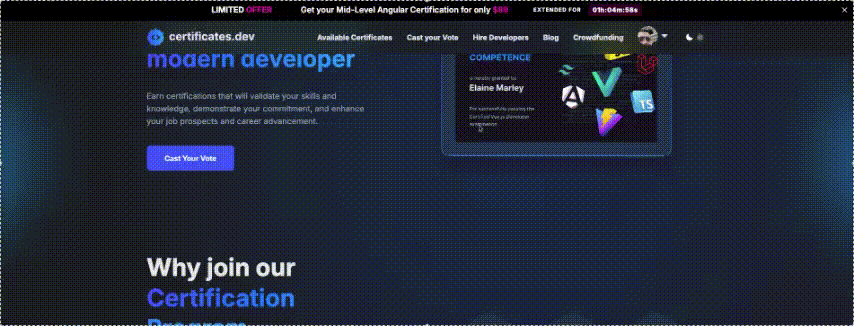
Day 0: First look at panel
My first impression after logging in was very positive! The dashboard’s color scheme references Angular’s rebranding. The interface is clear: on the left, there’s a panel with available functions and user information, while on the right, descriptions of available actions. The first thought that crossed my mind was, “It’s possible to create a great looking Angular themed page without using Material Design, right?”
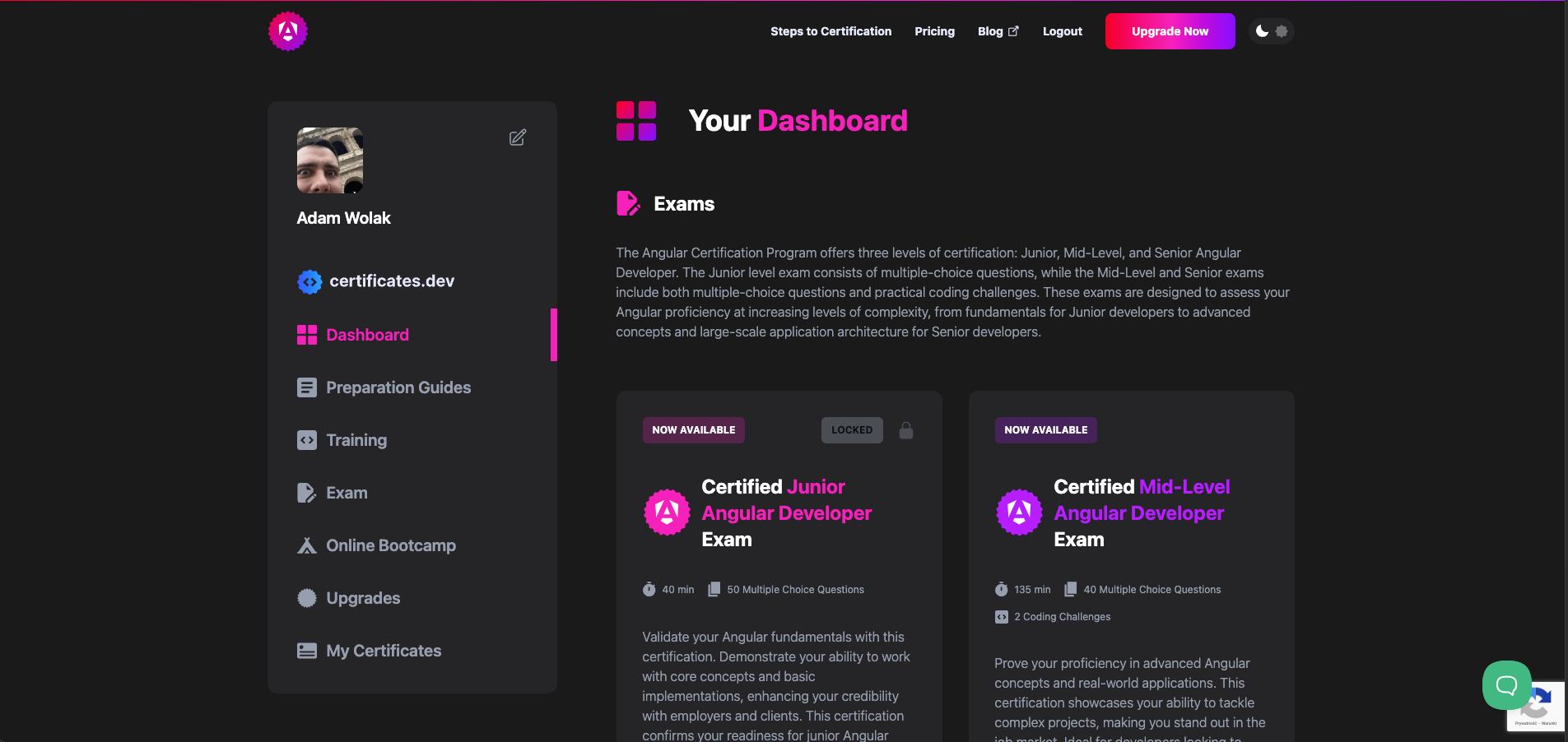
I was also pleasantly surprised by the mobile view. When I'm choosing a course, it's important for me to know which platforms I can access it from. Just like with news, sometimes I read on a larger screen during a work break, while at other times, I want to glance through something while I'm on the road (as a passenger, of course!) or before sleep. Surprisingly, the site is highly responsive.
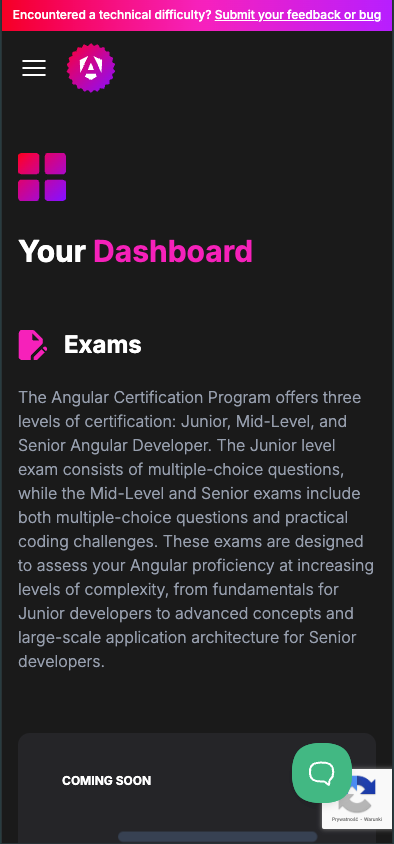
First day of training, and another days...
I wasn’t confident enough to take the full exam right away, so the next evening, I decided to go through some training lessons. The training section follows the same dashboard theme, with progress tracking on the left and main content on the right—everything remains clear and responsive.
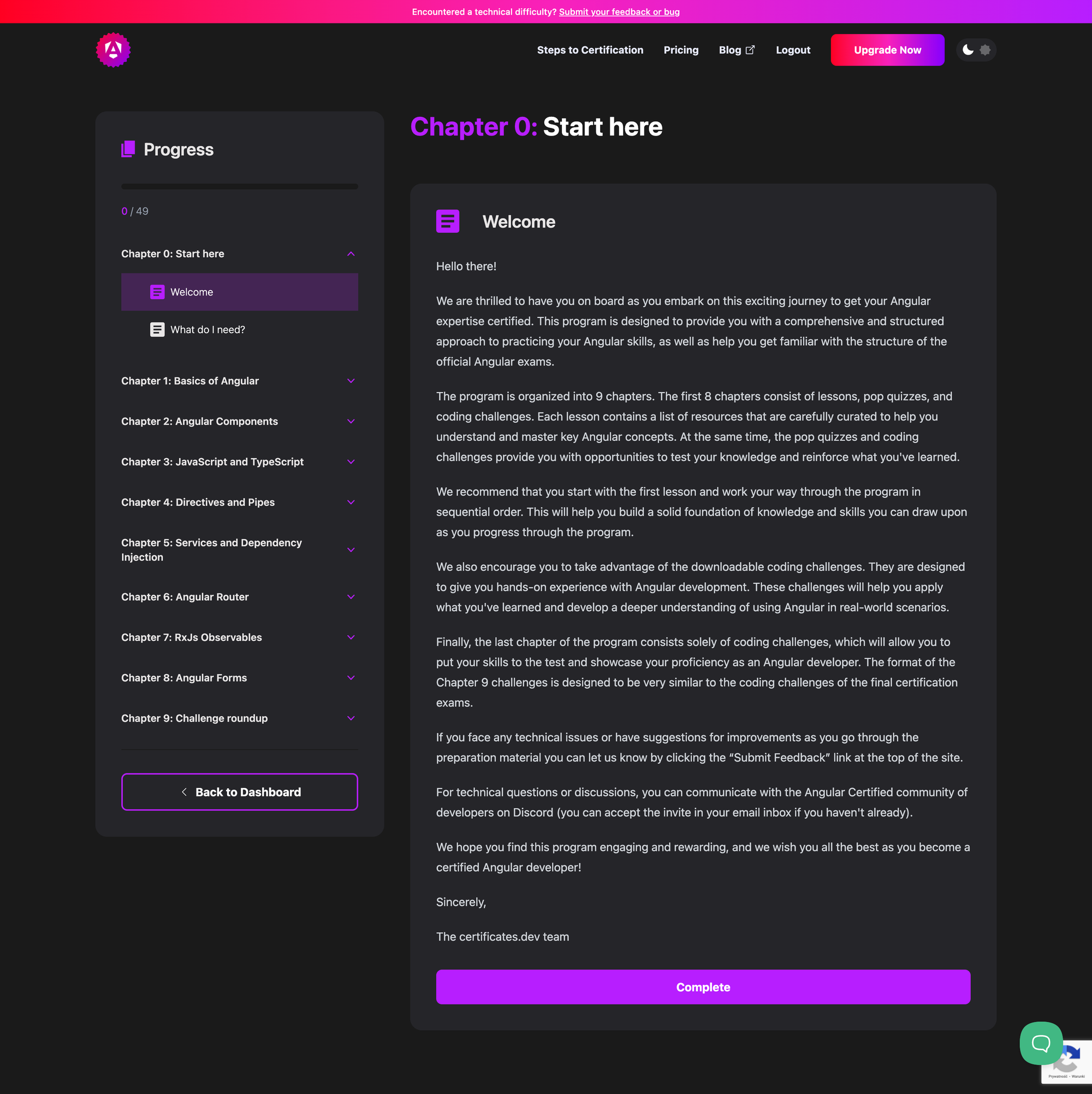
What surprised me was the format of the lessons.
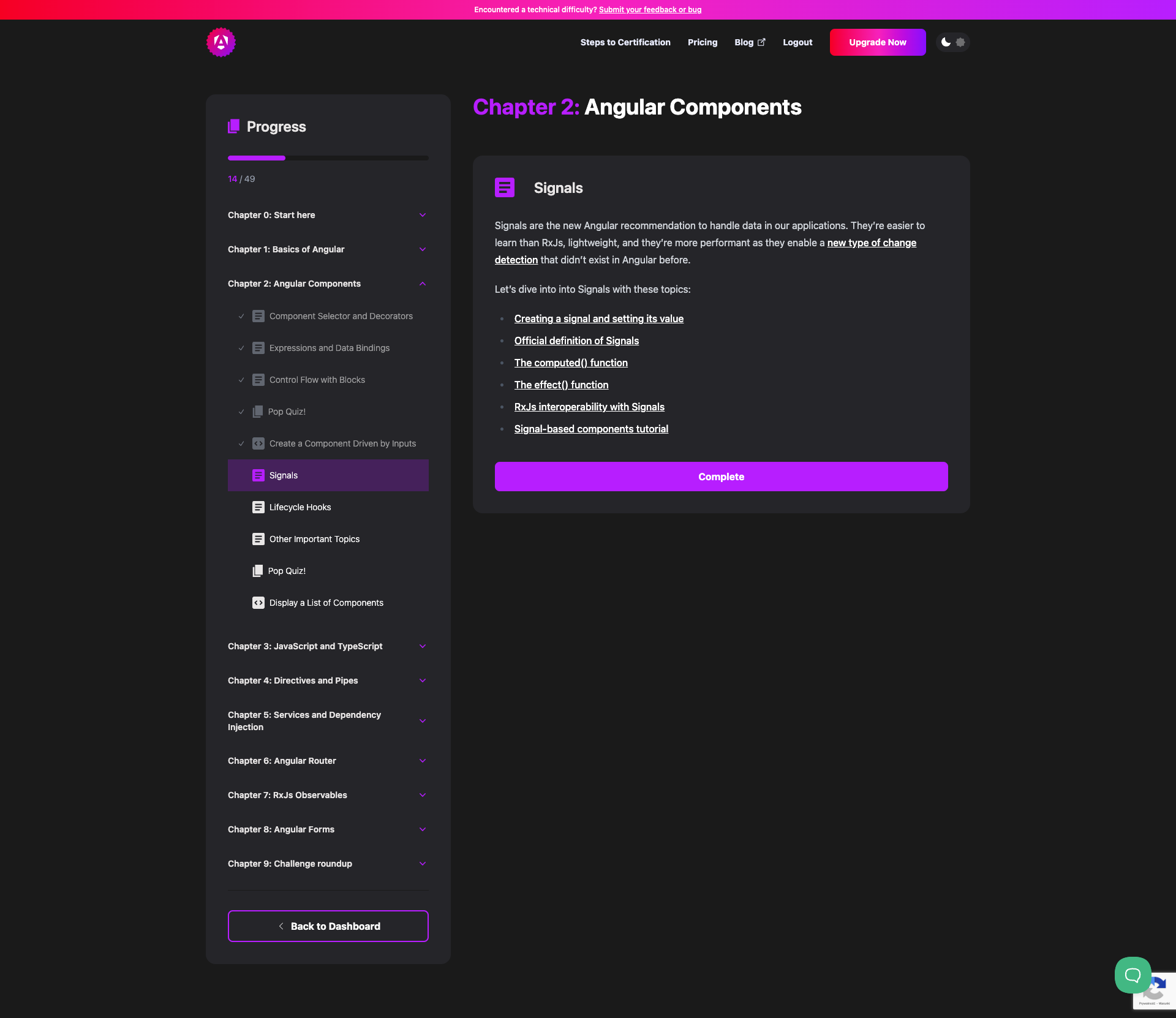
Above, you can see an example chapter dedicated to Signals in Angular. This is a completely different approach compared to other courses I’ve encountered.
I expected long-form articles or perhaps videos explaining the topic. Instead, we get a brief description of the lesson topic and a set of links to relevant resources.
At first, I was a bit confused by this approach. Some Angular topics are so complex that entire conference talks are dedicated to them—yet here, we only get a summary and a list of links. Does this mean the training is incomplete? Actually, no!
It took me some time to get used to this format. The links provided in the lessons mostly lead to the official Angular documentation, blog posts from Angular Training, or Medium articles written by Alain Chautard under the Angular Training brand. This is an interesting way to present training material: rather than lengthy lessons, the platform provides a knowledge base—concise, high-quality content that can be read in just a few minutes.
This is how an example article looks, it's about "Standalone Components":
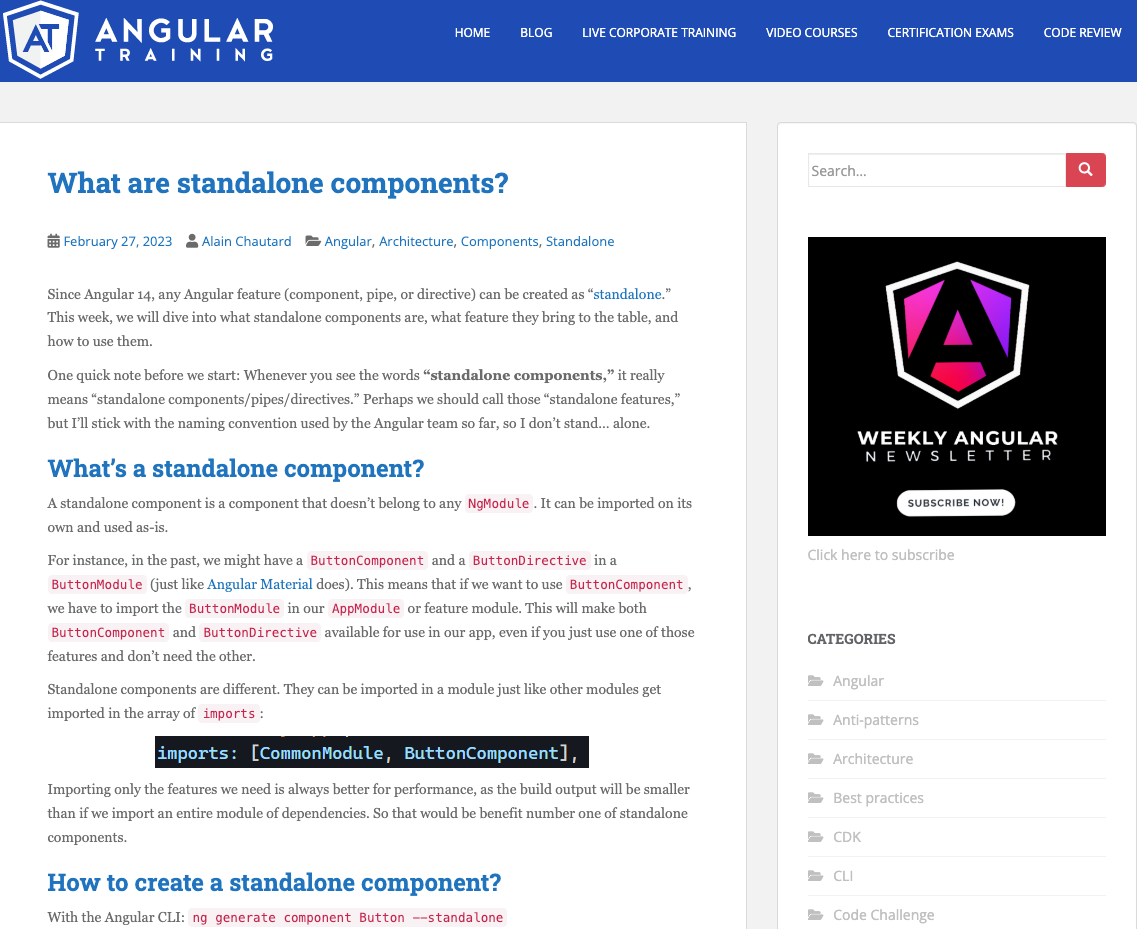
One might ask, "If these links are publicly available, why should I pay for someone who aggregates them into chapters?" My answer is simple: time-saving. The internet is full of articles of varying quality. In my experience, most of them are written as tutorials, where before getting to the core topic, you must wade through installation instructions for Node.js, Angular CLI, project setup, and library installations. Here, the provided content is curated by Google Developer Experts — free from unnecessary fluff focused on the topic. The authors assume you already have some knowledge, but a few paragraphs can refine and deepen your understanding.
However, this approach does have a drawback: taking this course on a mobile device becomes inconvenient. While I tried to complete lessons during breaks, opening and closing multiple browser tabs wasn’t comfortable. In the end, I had to finish certain lessons on my desktop.
From time to time, quizzes also appear!
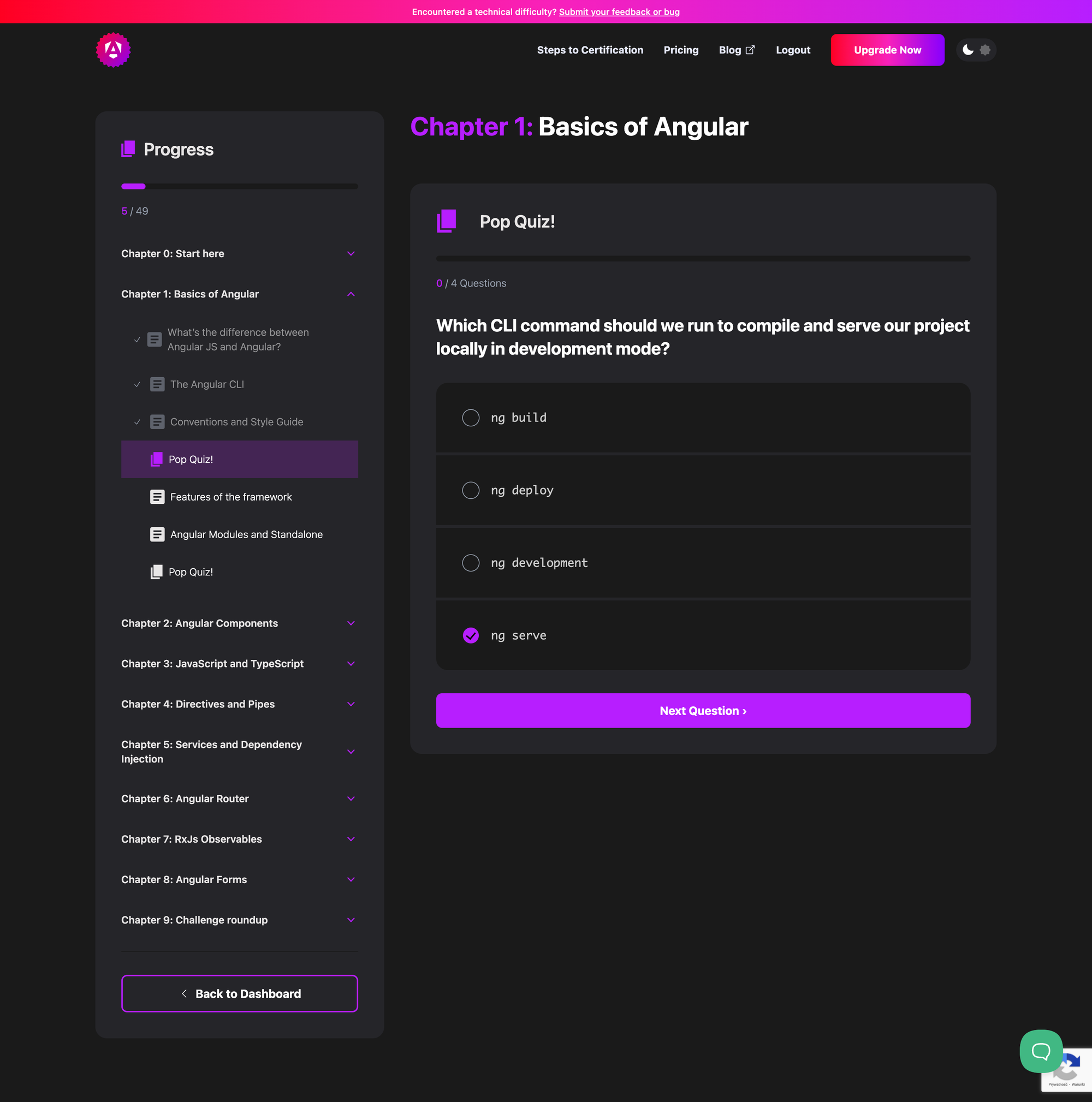
The quiz questions are relevant and refer to the topics covered in the chapter. I didn’t notice any mistakes, and they serve as a great way to reinforce learning.
Additionally, the course includes several challenges where you download a project and modify it according to given requirements.
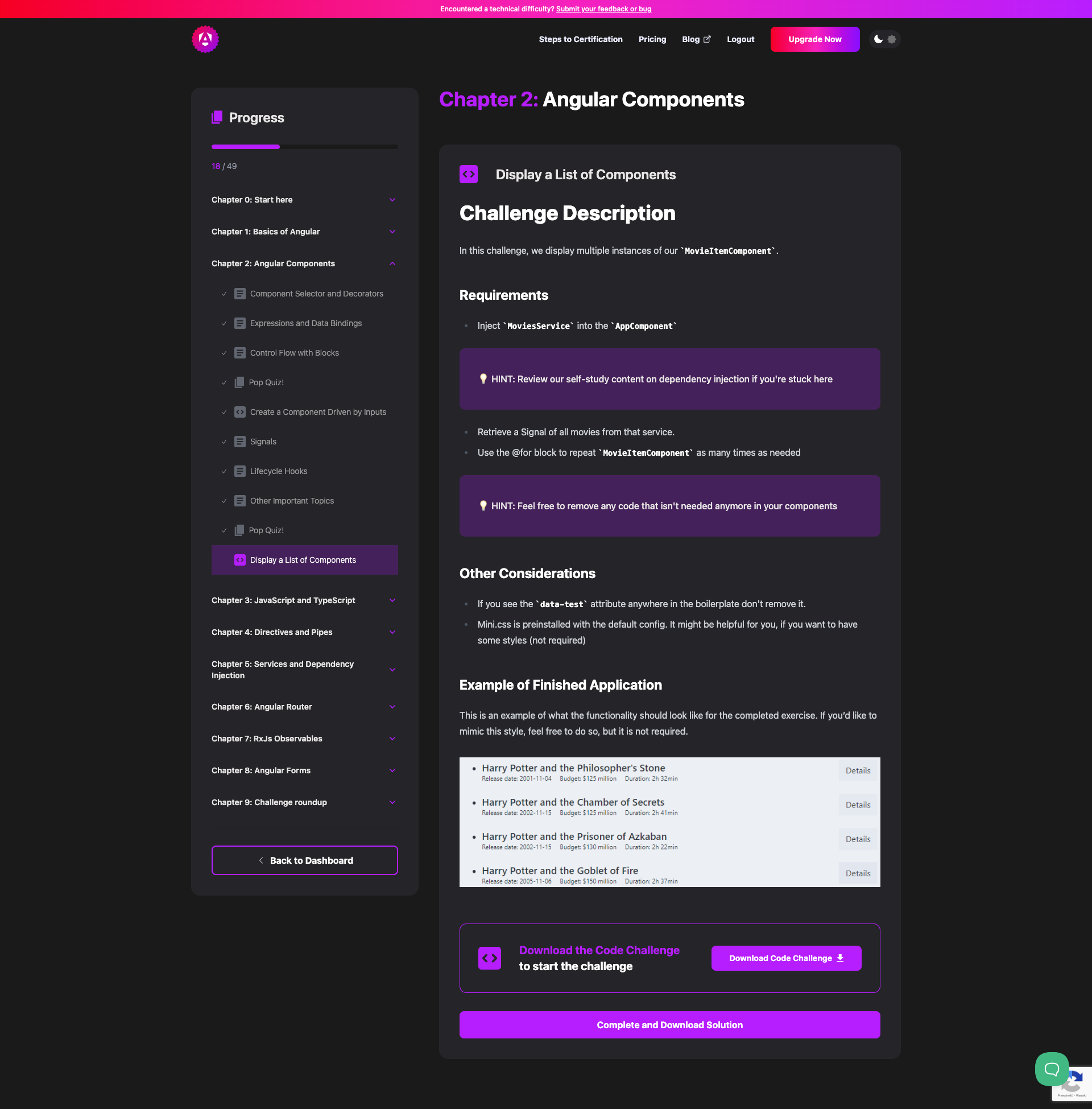
However, I missed one crucial feature — a way to verify if my implementation was correct. I understand that developing an automated grading system is time consuming and costly, implementing unit tests could be a solution. Instead of manually comparing projects, users could write code, test it in a browser, and run unit tests to check their work.
Completing the training took me a few days, spending about an hour daily reading articles, solving quizzes, and completing programming tasks. I believe a highly motivated person could finish it in just one day!
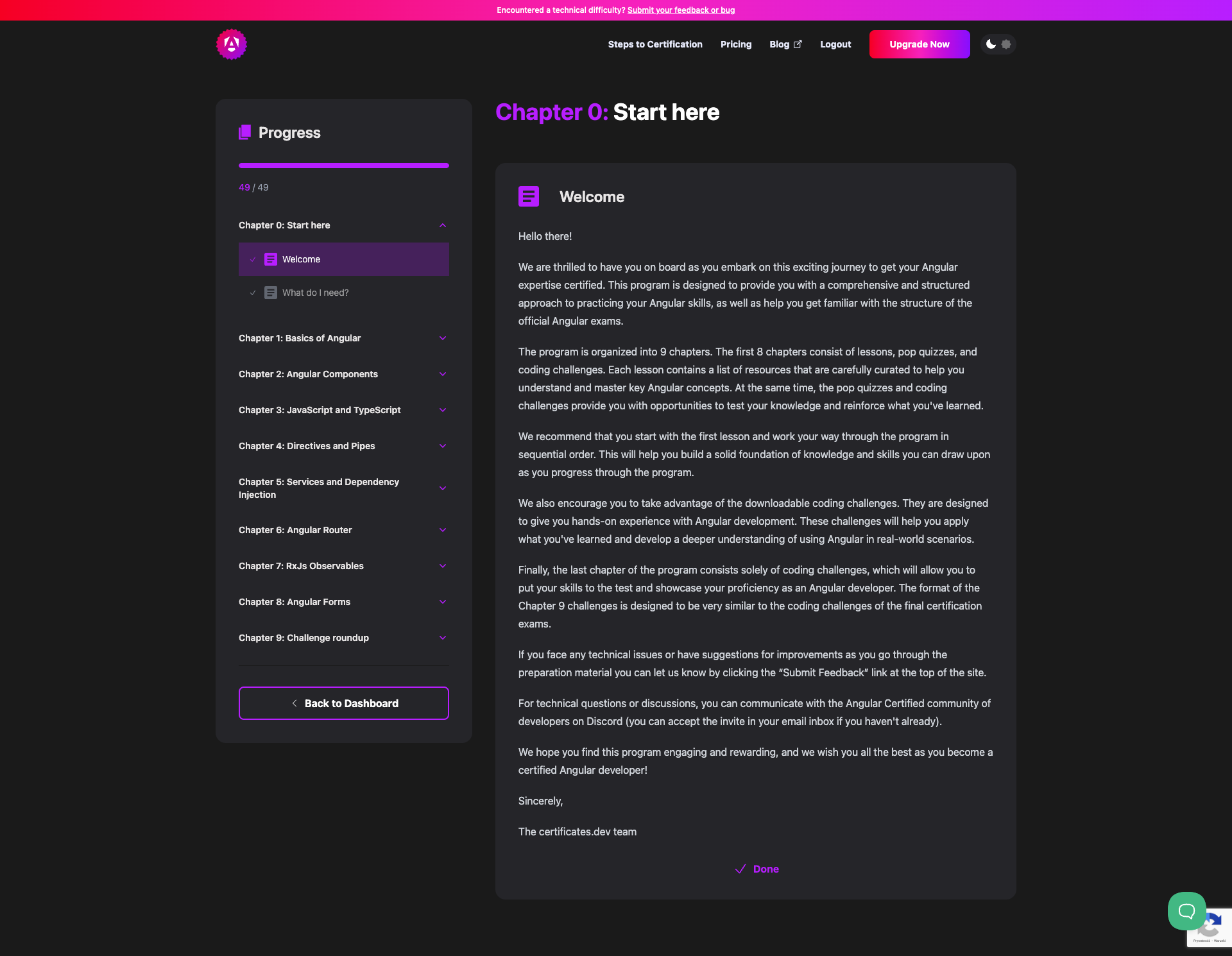
What was missing? It seems to me that a person at the “Mid” level should have a basic understanding of @ngrx/store, I missed a dedicated lesson that could describe this - even as an "add-on" that would not be included in the exam. I would have also supplemented chapter five on Dependency Injection, mentioned InjectionToken, "factory" in providers for component, module, and application. This was not present, perhaps these are advanced topics, but such knowledge is very welcome.
It's time to Exam!
After completing the entire training, we have the opportunity to take a "trial exam." This is a shortened version of what we can expect in the main exam—fewer questions, simpler coding tasks, and less time to complete them. Honestly, after the training, I felt confident and went straight to the main exam. The moment I started it, my heart began to race...
The exam takes itself very seriously. At the beginning, we are instructed on how the test works and how we should prepare for it. We are required to turn on our webcam and microphone, turn off our phone, and disconnect any additional screens from our device if applicable. External software verifies our identity, asks us to show our desk to check for any cheating attempts, and throughout the exam, we are continuously monitored — our webcam, microphone, and screen are recorded. These verification methods are not used for the trial exam, so for someone experiencing this for the first time, it can be nerve-wracking!
The exam is divided in two parts. The first part consists of a test with 40 closed questions. The questions are, of course, related to the knowledge gained during the training, primarily focusing on Angular. However, in my case, there were also a few questions related to JavaScript/TypeScript that required some thought. This section has a time limit of 30 minutes, and at least 29 correct answers are required to pass.
The second part is a practical exam, where we have to complete two tasks. In the first task, we must find and fix a bug in an existing application. The exam creators suggest spending about 15 minutes on this (it took me 25 minutes — shame on me!). The second task involves implementing certain functionalities in an application according to the given requirements. Fortunately, the application already includes templates and necessary data (which we would normally fetch from an API), so we only need to focus on implementing the logic in TypeScript. This part turned out to be quite manageable for me and I finished with 30 minutes to spare (not shame on me!).
Before the exam, we have access to a short video explaining how the practical section works, but I’ll describe it for those interested. Before starting, we receive a full description of what is expected from us. We work with an editor using StackBlitz, which includes all the necessary project files. This means we cannot use our preferred IDE, but instead, we get a toolbar with quick access to task requirements, the Angular documentation, and the MDN documentation. Clicking on these resources opens them in a "SideNav," which is a very well thought out solution. It keeps the code in view, prevents cheating, and best of all, does not require us to learn the entire documentation to pass the exam. If needed, we can quickly reference it during the exam. In my case, I had to use one of Angular’s built-in Pipes, which I had never used before. A quick look at the documentation helped me understand its parameters and implement the required functionality!
Once the exam ends, we are no longer tracked. I breathed a sigh of relief when I saw the message: "Thank you for completing the exam." The same message informed me that the grading process would take about five business days. However, the next morning, I checked my email and saw a message from Certificates.dev that...
I'm Certified Mid-Level Angular Developer!
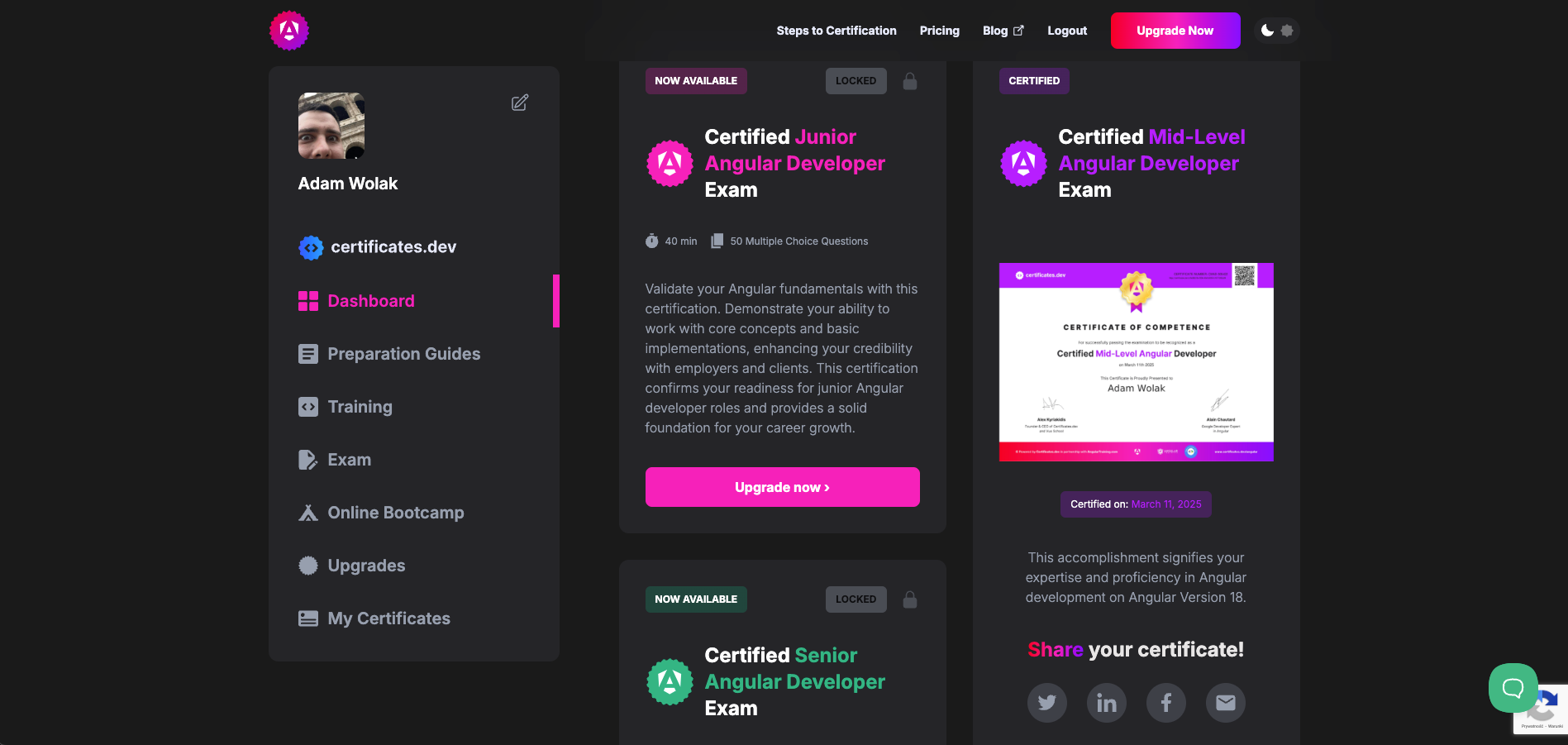
The certificate can be downloaded, shared on social media, and added to the "Licenses & Certifications" section of your LinkedIn profile to earn some likes from colleagues.
Summary
Would I recommend this platform for learning and certifying Angular skills? Absolutely! The training provides a solid dose of knowledge along with high quality articles from experts who truly know that stuff. The Mid-Level certification is well-balanced, and it covers exactly the topics I would expect to discuss with another "Mid-Level developer".
Once again, I would like to thank AngularSpace for the opportunity to test and verify my knowledge, but most importantly, a huge thanks to the creators of Certificates.dev — this platform is a remarkable achievement with a unique yet effective approach to delivering and validating knowledge. I hope that the certification I obtained will give me more confidence when discussing Angular topics.
I will keep an eye on this platform and will certainly take additional lessons from it. I'm rooting for the continued development of this platform and looking forward to even more certification options! I have already signed up for the React course, and in the future, I will likely go for the "Senior Angular Developer" training and certification — so see you soon!

